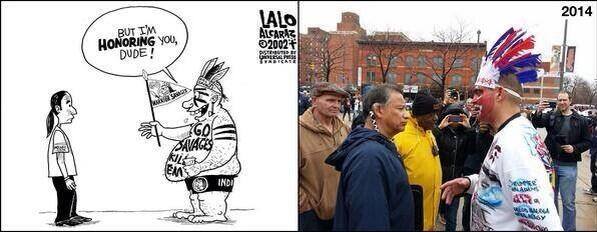
A 2002 cartoon and a 2014 photo depicting an encounter of a racist sports mascot. Image from Lalo Alcaraz
Peter d'Errico discusses the links between racist mascots and the treatment of Native people:
Eliminating a racist word carries a danger: In the process, we may forget the past that made the word racist. This, in turn, may allow us to ignore the ways in which that past continues in present institutions, not just in media. Refusing to use a derogatory term for Indians puts an end to racist language, but it does not put an end to the racist framework of laws that keep Indian country in a condition of colonialism. As Steve Newcomb pointed out, the "redskin" and mascot issues offer an opportunity to investigate the whole scheme of legalized domination we call "federal Indian law." That investigation does not appear to be happening on a widespread basis: "The Court’s use of a framework of domination for its decision [in Michigan v. Bay Mills Indian Community, May 2014] apparently hasn’t caused even the slightest emotional ripple among the leadership of Indian Country." Other issues present similar opportunities to dig beneath the surface to the deeper structural questions. For example, DaShanne Stokes's column about the 5th Circuit U.S. Appeals Court August 2014 decision that struck down a federal law restricting eagle feathers to federally-recognized tribes. Referring to recurring tensions between federal and state "recognized tribes," DaShanne wrote: "Federally recognized tribes should support state tribes on this. After all, if the 1940s to 1960s Termination era is any indication, federally recognized tribes are by no means immune from the threat of losing their recognition status. During Termination, over 100 tribes had their federal recognition status terminated." By pointing to the "termination" era, DaShanne reminded us of the dominating framework of federal Indian law, which presumes that the U.S. Congress has power to destroy the independent status of any Indian nation. That presumption erupted crudely in the "termination" laws that attacked the sovereignty of many Native nations. The eagle feather restrictions express the same presumption of federal superiority. By understanding this, we not only get DaShanne's point, we position ourselves to be alert to other examples of institutionalized racism based on religious discrimination against Indians.Get the Story:
Peter d'Errico: Connect the Dots: Mascots, Feathers, Termination ... Domination (Indian Country Today 9/18)
Join the Conversation